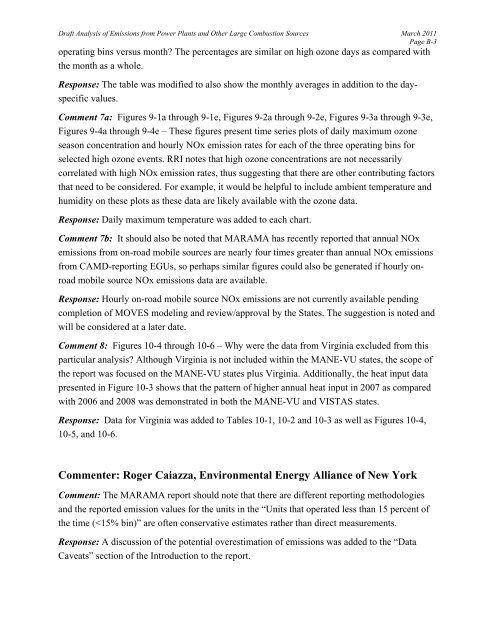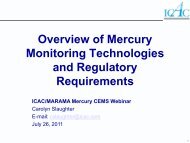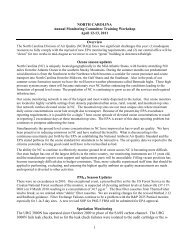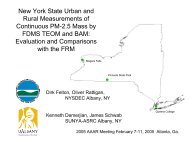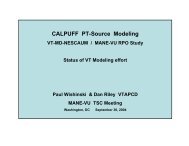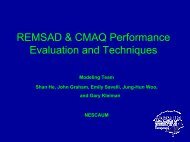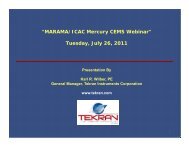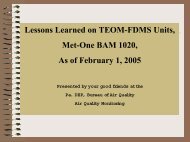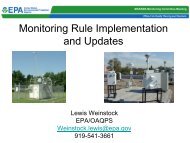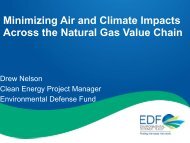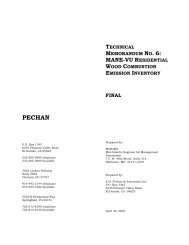Analysis of 2007 Emissions from Power Plants and Other ... - MARAMA
Analysis of 2007 Emissions from Power Plants and Other ... - MARAMA
Analysis of 2007 Emissions from Power Plants and Other ... - MARAMA
You also want an ePaper? Increase the reach of your titles
YUMPU automatically turns print PDFs into web optimized ePapers that Google loves.
Draft <strong>Analysis</strong> <strong>of</strong> <strong>Emissions</strong> <strong>from</strong> <strong>Power</strong> <strong>Plants</strong> <strong>and</strong> <strong>Other</strong> Large Combustion Sources March 2011Page B-3operating bins versus month? The percentages are similar on high ozone days as compared withthe month as a whole.Response: The table was modified to also show the monthly averages in addition to the dayspecificvalues.Comment 7a: Figures 9-1a through 9-1e, Figures 9-2a through 9-2e, Figures 9-3a through 9-3e,Figures 9-4a through 9-4e – These figures present time series plots <strong>of</strong> daily maximum ozoneseason concentration <strong>and</strong> hourly NOx emission rates for each <strong>of</strong> the three operating bins forselected high ozone events. RRI notes that high ozone concentrations are not necessarilycorrelated with high NOx emission rates, thus suggesting that there are other contributing factorsthat need to be considered. For example, it would be helpful to include ambient temperature <strong>and</strong>humidity on these plots as these data are likely available with the ozone data.Response: Daily maximum temperature was added to each chart.Comment 7b: It should also be noted that <strong>MARAMA</strong> has recently reported that annual NOxemissions <strong>from</strong> on-road mobile sources are nearly four times greater than annual NOx emissions<strong>from</strong> CAMD-reporting EGUs, so perhaps similar figures could also be generated if hourly onroadmobile source NOx emissions data are available.Response: Hourly on-road mobile source NOx emissions are not currently available pendingcompletion <strong>of</strong> MOVES modeling <strong>and</strong> review/approval by the States. The suggestion is noted <strong>and</strong>will be considered at a later date.Comment 8: Figures 10-4 through 10-6 – Why were the data <strong>from</strong> Virginia excluded <strong>from</strong> thisparticular analysis? Although Virginia is not included within the MANE-VU states, the scope <strong>of</strong>the report was focused on the MANE-VU states plus Virginia. Additionally, the heat input datapresented in Figure 10-3 shows that the pattern <strong>of</strong> higher annual heat input in <strong>2007</strong> as comparedwith 2006 <strong>and</strong> 2008 was demonstrated in both the MANE-VU <strong>and</strong> VISTAS states.Response: Data for Virginia was added to Tables 10-1, 10-2 <strong>and</strong> 10-3 as well as Figures 10-4,10-5, <strong>and</strong> 10-6.Commenter: Roger Caiazza, Environmental Energy Alliance <strong>of</strong> New YorkComment: The <strong>MARAMA</strong> report should note that there are different reporting methodologies<strong>and</strong> the reported emission values for the units in the “Units that operated less than 15 percent <strong>of</strong>the time (


